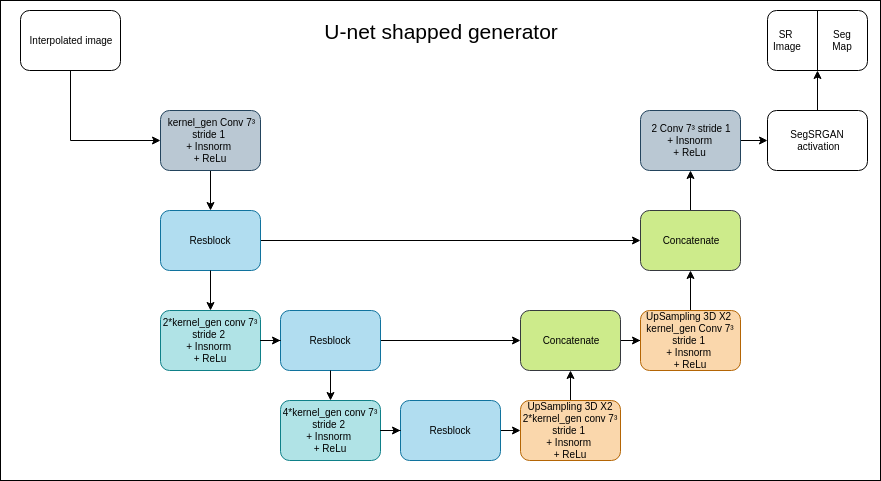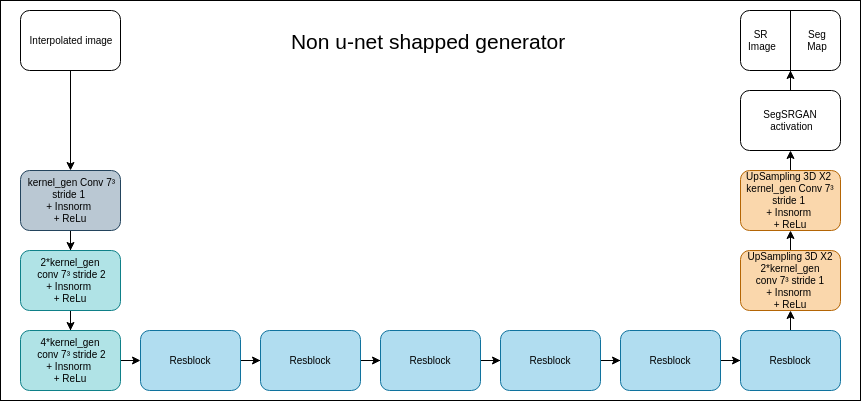Segmentation and super resolution GAN network
Project description
SegSRGAN
This algorithm is based on the method proposed by Chi-Hieu Pham in 2019. More information about the SEGSRGAN algorithm can be found in the article
Installation
User (recommended)
The library can be installed using Pypi
pip install SegSRGAN
NOTE: We recommend to use virtualenv
If the package is installed, one can find all the .py file presented hereafter using the importlib python package as follow :
importlib.util.find_spec("SegSRGAN").submodule_search_locations[0]
Developer
First, clone the repository. Use the make to run the testsuite
or yet create the pypi package.
git clone git@github.com:koopa31/SegSRGAN.git
make test
make pkg
make
Installation
pip install SegSRGAN
Perform a training:
Example :
python SegSRGAN_training.py
−−new_low_res 0.5 0.5 3
−−csv /home/user/data.csv
−−snapshot_ folder /home/user/training_weights
−−dice_file /home/user/dice.csv
−−mse_ file /home/user/mse_example_for_article.csv
−−folder_training_data/home/user/temporary_file_for_training
Options :
#### General options :
- csv (string): CSV file that contains the paths to the files used for training. These files are divided into two categories: train and test. Consequently, it must contain 3 columns, called: HR_image, Label_image and Base (which is equal to either or Test), respectively
- dice_file (string): CSV file where to store the DICE at each epoch
- mse_file(string): MSE file where to store the DICE at each epoch
- folder_training_data (string): folder which contains the training images database
- epoch (integer) : number of training epochs
- batch_size (integer) : number of patches per mini batch
- number_of_disciminator_iteration (integer): how many times we train the discriminator before training the generator
- new_low_res (tuple): resolution of the LR image generated during the training. One value is given per dimension, for fixed resolution (e.g.“−−new_low_res 0.5 0.5 3”). Two values are given per dimension if the resolutions have to be drawn between bounds (e.g. “−−new_low_res 0.5 0.5 4 −−new_low_res 1 1 2” means that for each image at each epoch, x and y resolutions are uniformly drawn between 0.5 and 1, whereas z resolution is uniformly drawn between 2 and 4.
- snapshot_folder (string): path of the folder in which the weights will be regularly saved after a given number of epochs (this number is given by snapshot (integer) argument). But it is also possible to continue a training from its saved weight, adding the following parameters:
- folder_training_data (string): folder where temporary files are written during the training (created at the begining of each epoch and deleted at the end of it)
- initepoch (integer): number of the epoch from which the training will continue
- weights (string): path to the saved weights from which the training will continue
- batch_size (integer): number of patches per mini-batch.
Network architecture options :
- kernel_gen (integer): number of output channels of the first convolutional layer of the generator.
- kernel_dis (integer): number of output channels of the first convolutional layer of the discriminator.
- is_conditional (Boolean): enables to train a conditional network with a condition on the input resolution (discriminator and generator are conditionnal)
- u_net (Boolean): enables to train U-Net network (see difference between u-net and non u-net network in the images below).
- is_residual (Boolean): determines whether the structure of the network is residual or not. This option only impact the activation function of the generator (see image below for more detail).

Residual vs non residual network
 |
|---|
 |
| U-net vs non u-net shaped network |
Options for continuing a training from set of weights :
- init_epoch (integer): number of the first epoch which will be considered during the continued training (e.g., 21 if the weights given were those obtained at the end of the 20th epoch). This is mainly useful for writing the weights in the same folder as the training which is continued. Warning – The number of epochs of the remaining training is then epoch − initepoch +1.
- weights (string): path to the saved weights from which the training will continue.
Options for data augmentation :
- percent_val_max: multiplicative value that gives the ratio of the maximal value of the image, for defining the standard deviation of the additive Gaussian noise. For instance, a value of $0.03$ means that $\sigma = 0.03 \max(X)$ where $\max(X)$ is the maximal value of the image $X$.
- contrast_max: controls the modification of contrast of each image. For instance, a value of 0.4 means that at each epoch, each image will be set to a power uniformly drawn between 0.6 and 1.4.
Perform a segmentation :
Two way are available to perform segmentation :
- In command line (mainly usefull to process several segmentation)
- Using a python function.
Python function :
As one can see in the testsuite/seg.py file, the python function can be used as follow :
from SegSRGAN.Function_for_application_test_python3 import segmentation
segmentation( input_file_path, step, new_resolution, patch, path_output_cortex, path_output_hr, weights_path)
Where:
- input_file_path is the path of the image to be super resolved and segmented
- step is the shifting step for the patches
- new_resolution is the new z-resolution we want for the output image
- path_output_cortex output path of the segmented cortex
- path_output_hr output path of the super resolution output image
- weights_path is the path of the file which contains the pre-trained weights for the neural network
- patch is the size of the patches
Segmentation of a set of images with several step and patch values
In order to facilitate the segmentation of several images, you can run SegSRGAN/SegSRGAN/job_model.py:
python job_model.py
--path
--patch
--step
--result_folder_name
--weights_path
The list of the paths of the images to be processed must be stored in a csv file.
Where:
- path : Path of the csv file
- patch : list of patch sizes
- step : list of steps
- result_folder_name : Name of the folder containing the results
Example of syntax for step and patch setting:
--patch 64,128
--step 32 64,64 128
In this example we run steps 32 and 64 for patch 64 and steps 64 and 128 for patch 128. Be careful to respect the exact same spaces.
Project details
Release history Release notifications | RSS feed
Download files
Download the file for your platform. If you're not sure which to choose, learn more about installing packages.













